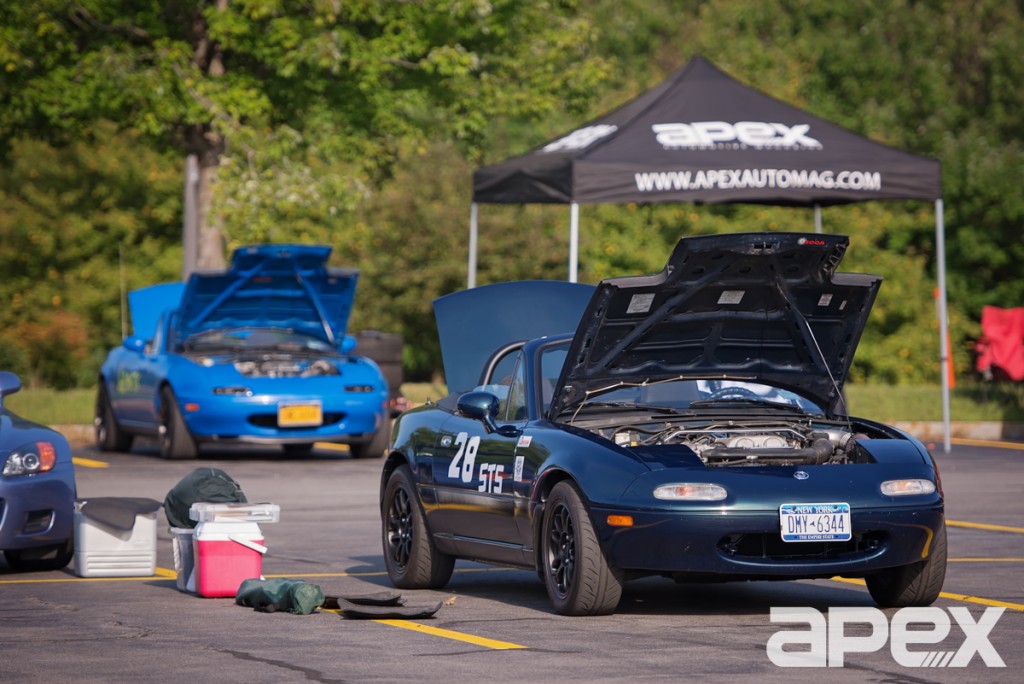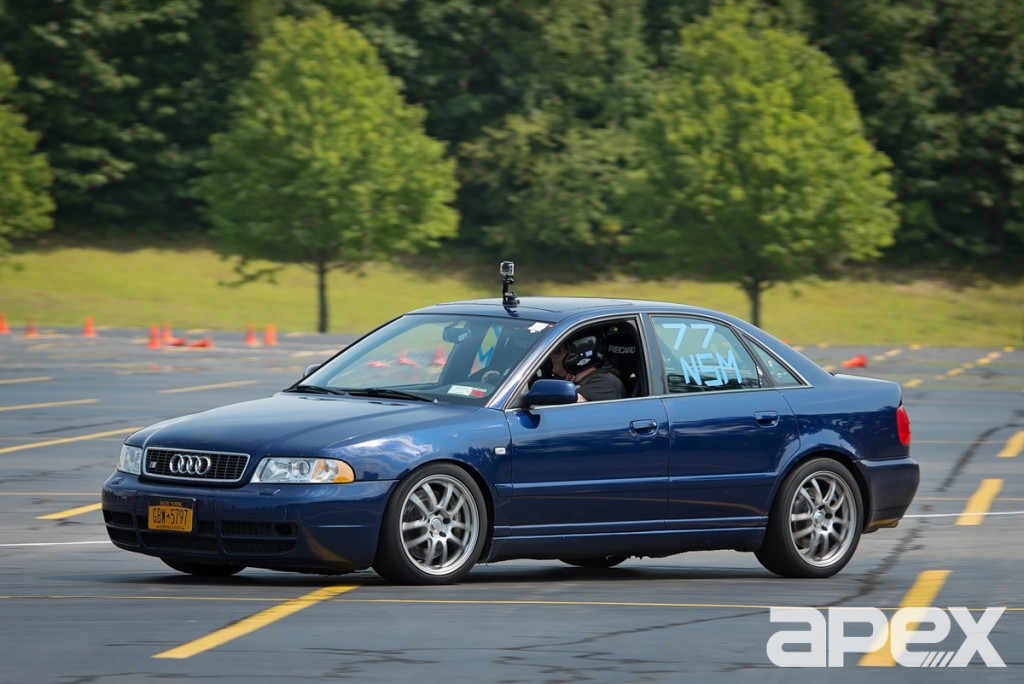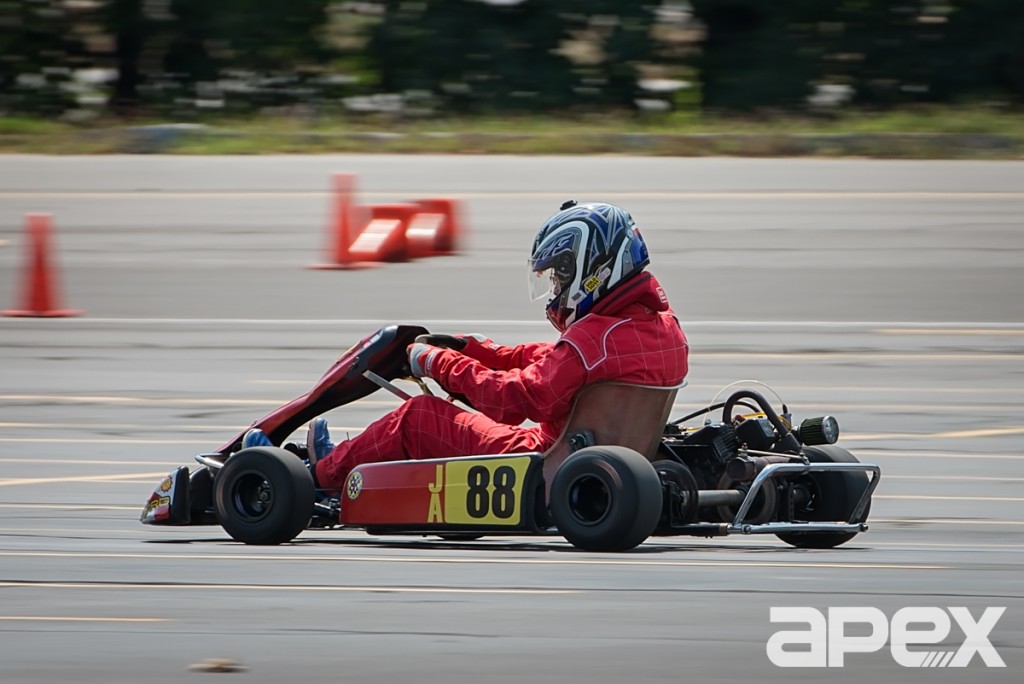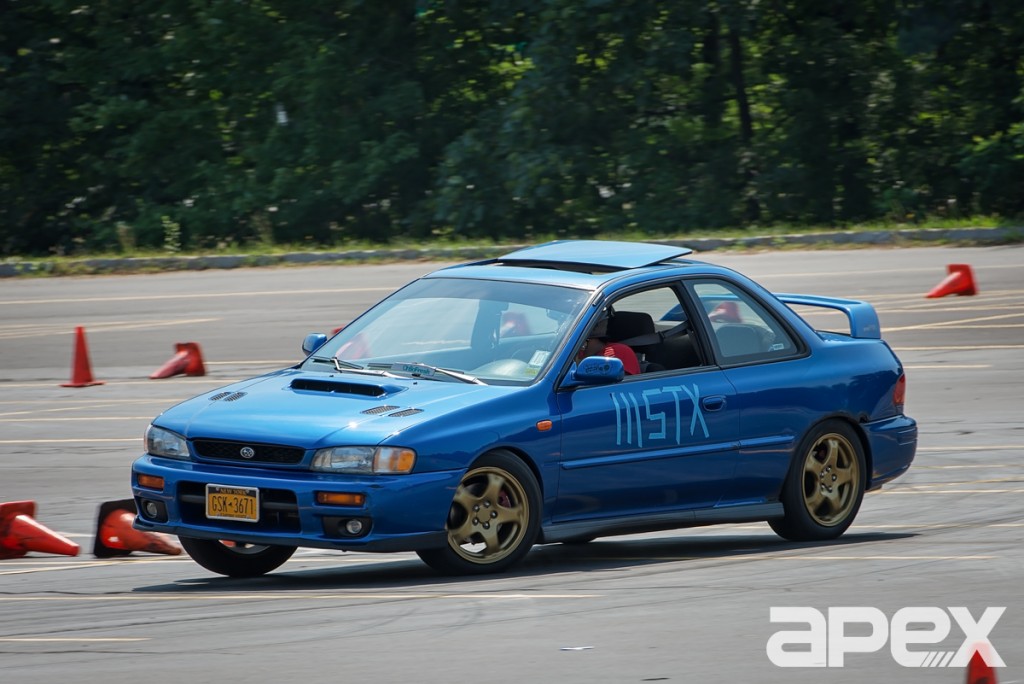 Most people aren’t willing or able to invest gobs of money to prep and maintain a car for the track. Then there’s the question of how do I start this hobby – how do I dip my toe in?
Most people aren’t willing or able to invest gobs of money to prep and maintain a car for the track. Then there’s the question of how do I start this hobby – how do I dip my toe in?
The answer for most, hands down, is autocross.
While APEX was at Street Scene this year, I took a walk around to see what ven-dors had to offer. I met with the folks from the CNY Region SCCA – the Sports Car Club of America. They seemed like nice fellas, and they invited me to one of their many autocross events held throughout the year. The following week I was on my way to a parking lot outside Fulton County Community College to see what this was all about.
This wasn’t my first foray into the world of performance driving. I started doing track days three years ago when my mechanic, who happened at the time to be an active volunteer of the Northeast Quattro Audi Club, cajoled me into driving my recently purchased Audi A4 wagon around Watkins Glen at speed. I haven’t looked back since, and today I have a track-prepped 2001 2.7 Twin turbo Audi S4 which I track about four times a year. The bug bit me hard, but it’s fair to say, it has taken a bite out of my wallet too; modifying my car up to 400hp with uprated brakes, down-pipes, turbos, suspension, clutch and more.
 So imagine my surprise when my sporty track car was beaten round the CNY SCCA Autocross Solo course by far slower, less modified cars. I was out-driven, and I loved it!
So imagine my surprise when my sporty track car was beaten round the CNY SCCA Autocross Solo course by far slower, less modified cars. I was out-driven, and I loved it!
Autocross, or Solo as the SCCA calls it, is essentially a short racetrack built with nothing more than an open parking lot and a lot of traffic cones. The cars range from basic daily drivers, some bone stock or with modest modifications, all the way up to custom built roadsters, stripped Miatas, stanced imports, and hot hatches.
The equalizer is the PAX system – which provides everyone an opportunity to compare their times against each other. It handicaps the faster cars, which run in faster classes and provides a ratio designed to equalize times. In theory the best man out there will end up with the best time after PAX adjustment.
 I arrived at 8 a.m., and popped up the APEX canopy tent, torqued my lug nuts and checked my oil. I then headed over to the registration tent to pay $40, which included a $10 fee for a single event membership and $30 for the event itself. The cost of a SCCA membership is comprised of $65 national dues plus Region dues ranging from $0 – $25, if you want to run in many events.
I arrived at 8 a.m., and popped up the APEX canopy tent, torqued my lug nuts and checked my oil. I then headed over to the registration tent to pay $40, which included a $10 fee for a single event membership and $30 for the event itself. The cost of a SCCA membership is comprised of $65 national dues plus Region dues ranging from $0 – $25, if you want to run in many events.
There were about fifteen cars there already and soon after another fifteen or so showed up. I understand event numbers can be north of 75 vehicles, but normally run in the 30-50 range.
Everyone was sorted into their class, and letters signifying that class were on each vehicle along with a number. I was in the NSM class which meant I was a “Novice Street Modified.” Most people hadn’t mod-ified their car as much and were running in different classes. My R-Comp tires and my chip, turbo and exhaust pretty much put my car into the modified class, and my PAX multiplier would reflect the expectation that my car should be fast.
There were about six other novices at the event and we walked the track before the event so we could learn the line and get a feel for the corners. One of the veteran solo racers came along and pointed out rac-ing line considerations and gave advice on how we could run the fastest. Today’s track included a slalom-style line of cones that we would weave around, a big circle at one end of the track, followed by another short slalom into a short straight, and ending with the right-hander near the start. On the first lap you’d sweep right and run the course once again. On the second lap, you’d swing back left into the finish line.
 We were split into three run-groups. Two groups each had about fifteen cars, and then a teenager on his go-kart. Kids are welcome to autocross too in age appropriate vehicles. When you weren’t running, you were manning a corner of the track with an-other racer replacing cones that got knocked over or out of their marked boxes, and communicating back to a scorer to let them know when a struck cone meant they would need to add a two-second penalty.
We were split into three run-groups. Two groups each had about fifteen cars, and then a teenager on his go-kart. Kids are welcome to autocross too in age appropriate vehicles. When you weren’t running, you were manning a corner of the track with an-other racer replacing cones that got knocked over or out of their marked boxes, and communicating back to a scorer to let them know when a struck cone meant they would need to add a two-second penalty.
I was up in the first group and ran exceedingly badly the first time. It was hard to get the hang of the slalom and it was easy to carry too much speed in the corners and get out of shape quickly. You could strike a cone, go off course or simply lose time when correcting. It was also hard to remember the track and stay on line. You are essentially staring at a sea of cones! Each time out was the two-lap course, and I was pleased to hear we’d get three runs in the morning and four in the afternoon. I’d need the whole day to get used to the track and how my car was acting in the corners.
 After three runs our group was done and the second group lined up to race while I manned my corner. I found it useful to watch others running the track to see what lines they were taking, where they were on the gas, and where they were braking. I suddenly realized how badly I was doing watching some of these cars whip around the track with great accuracy.
After three runs our group was done and the second group lined up to race while I manned my corner. I found it useful to watch others running the track to see what lines they were taking, where they were on the gas, and where they were braking. I suddenly realized how badly I was doing watching some of these cars whip around the track with great accuracy.
During the break for lunch we took the opportunity to compare our lap times, both before and after PAX adjustment. Sadly, after adjustment I was one of the lower scoring drivers. It was a really friendly group of folks and people were keen to talk to me about my car. Doing something like this for the first time can be intimidating, but I can truly say that the CNY Region SCCA welcomed me with open arms.
The afternoon runs were a few seconds faster, but in three out of four I knocked over a cone each time, which added back the few seconds gained. It was my last run of the day where I hooked everything up and kept it clean for both laps. When everyone’s run was complete I had come in eighth position out of thirty for raw time, and fifteenth position after PAX adjust-ment. Not too shabby for my first event, but boy – did the people at the top of the page put in some incredible times.
 Seeing how quickly people can take daily drivers with road tires around these tracks gave me a whole new appreciation for how much I had to learn about driving fast on a tight track and also how much damn fun you can have for $40. There is no need to prep or modify your car for autocross. You’ll have an absolute riot out there all for less than the cost of dinner and a movie.
Seeing how quickly people can take daily drivers with road tires around these tracks gave me a whole new appreciation for how much I had to learn about driving fast on a tight track and also how much damn fun you can have for $40. There is no need to prep or modify your car for autocross. You’ll have an absolute riot out there all for less than the cost of dinner and a movie.
The CNY regions SCCA run around 10 events each year, and I’ll be back for sure. I know at least three friends who will want to do this with me next time. I could see this becoming a fixture for my performance-driving addiction once or twice each year, and maybe in a few years, my five-year-old will be ready to get a restricted go-kart and run it at these events too.
When I upgrade in a few years to my next daily driver, I might consider picking something small, light and fast, that’s go-ing to go well round these tracks. A Golf GTI perhaps or a Subaru STI. Solo events are definitely something to try on for size. It’s not enough to have a car that looks good or be quick in a straight line, you’ll want to find out if you can handle those corners too.
Story by: Matt Wilson
Photos by: Jordan Polizzi
